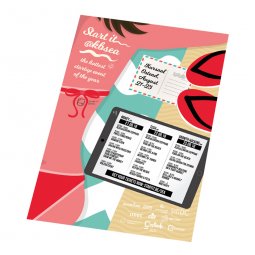Overprint and transparencies
Overprint and transparencies can cause your product looking differently than expected. The problem is that you don't always notice that these options are active when viewing the file on your screen. But afterwards, when the product is printed, you might notice that something is wrong. And then it's too late of course ...
Overprint
In case of overprint, layers that overlap are mixed with each other. This means that not only the upper layer is visible, but also the layer(s) below. This may lead to unexpected results. In the figures below we see the intended design on the left. If the yellow area is in overprint, we get the result that can be seen on the right. The problem is that in this situation, Adobe Illustrator does not show any difference whether overprint is switched on or off. Read about how you can turn overprint on and off and how to detect it.

Figure 1: an example of overprint with the yellow surface
Note: white objects in overprint are not printed. This is because in case of overprint, the colors of the different layers are mixed. The problem is that in CMYK we create the color white by using no colors. Since the white layer contains no colors, the other layers will be mixed with an empty one. More information about CMYK.
But don't be confused, overprint is not useless, on the contrary. It is mainly used for black text, which is only composed of 100% K (Key or black), on a colored background.
Take a look at figure 2; if we don't use overprint, the orange background would be printed first, leaving out the parts where the texts will be printed. These areas would remain white (left image). If the print plate moves only half a millimeter before the second layer is printed, we will get white edges (middle image). With overprint the entire background is printed without cut-outs for the text, which is then printed over the background (right-hand image).

Figure 2: example showing the usefulness of overprint for text in a colored surface
Caution: the use of overprint for objects that are not black is not recommended. If you do use this setting for such objects, there is a risk the print will be poorly visible or not visible at all. The use of overprint is completely at your own risk.
Transparencies
Transparencies are objects or images that are partially or completely transparent. As a result, the bottom layer shines through in the upper layer and, like overprint, colors of different layers are mixed.
If you use effects like drop shadow, glow effect or fade out, make sure that all transparencies are flattened to avoid unwanted results. Read more about the correct flattening of transparencies.



